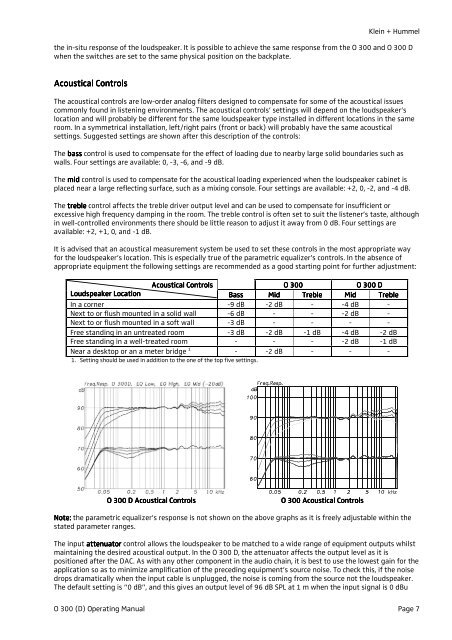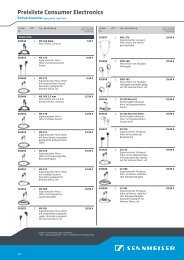O 300 (D) Operating Manual v01 - Klein + Hummel
O 300 (D) Operating Manual v01 - Klein + Hummel
O 300 (D) Operating Manual v01 - Klein + Hummel
You also want an ePaper? Increase the reach of your titles
YUMPU automatically turns print PDFs into web optimized ePapers that Google loves.
<strong>Klein</strong> + <strong>Hummel</strong><br />
the in-situ response of the loudspeaker. It is possible to achieve the same response from the O <strong>300</strong> and O <strong>300</strong> D<br />
when the switches are set to the same physical position on the backplate.<br />
Acoustical Controls<br />
The acoustical controls are low-order analog filters designed to compensate for some of the acoustical issues<br />
commonly found in listening environments. The acoustical controls’ settings will depend on the loudspeaker’s<br />
location and will probably be different for the same loudspeaker type installed in different locations in the same<br />
room. In a symmetrical installation, left/right pairs (front or back) will probably have the same acoustical<br />
settings. Suggested settings are shown after this description of the controls:<br />
The bass control is used to compensate for the effect of loading due to nearby large solid boundaries such as<br />
walls. Four settings are available: 0, -3, -6, and -9 dB.<br />
The mid<br />
control is used to compensate for the acoustical loading experienced when the loudspeaker cabinet is<br />
placed near a large reflecting surface, such as a mixing console. Four settings are available: +2, 0, -2, and -4 dB.<br />
The treble control affects the treble driver output level and can be used to compensate for insufficient or<br />
excessive high frequency damping in the room. The treble control is often set to suit the listener’s taste, although<br />
in well-controlled environments there should be little reason to adjust it away from 0 dB. Four settings are<br />
available: +2, +1, 0, and -1 dB.<br />
It is advised that an acoustical measurement system be used to set these controls in the most appropriate way<br />
for the loudspeaker’s location. This is especially true of the parametric equalizer’s controls. In the absence of<br />
appropriate equipment the following settings are recommended as a good starting point for further adjustment:<br />
Acoustical Controls<br />
O <strong>300</strong><br />
O <strong>300</strong> D<br />
Loudspeaker Location<br />
Bass<br />
Mid<br />
Treble<br />
Mid<br />
Treble<br />
In a corner -9 dB -2 dB - -4 dB -<br />
Next to or flush mounted in a solid wall -6 dB - - -2 dB -<br />
Next to or flush mounted in a soft wall -3 dB - - - -<br />
Free standing in an untreated room -3 dB -2 dB -1 dB -4 dB -2 dB<br />
Free standing in a well-treated room - - - -2 dB -1 dB<br />
Near a desktop or an a meter bridge 1 - -2 dB - - -<br />
1. Setting should be used in addition to the one of the top five settings.<br />
O <strong>300</strong> D Acoustical Controls O <strong>300</strong> Acoustical Controls<br />
Note: the parametric equalizer’s response is not shown on the above graphs as it is freely adjustable within the<br />
stated parameter ranges.<br />
The input attenuator control allows the loudspeaker to be matched to a wide range of equipment outputs whilst<br />
maintaining the desired acoustical output. In the O <strong>300</strong> D, the attenuator affects the output level as it is<br />
positioned after the DAC. As with any other component in the audio chain, it is best to use the lowest gain for the<br />
application so as to minimize amplification of the preceding equipment’s source noise. To check this, if the noise<br />
drops dramatically when the input cable is unplugged, the noise is coming from the source not the loudspeaker.<br />
The default setting is “0 dB”, and this gives an output level of 96 dB SPL at 1 m when the input signal is 0 dBu<br />
O <strong>300</strong> (D) <strong>Operating</strong> <strong>Manual</strong> Page 7










